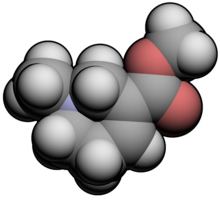Arecoline
 | |
 | |
| Clinical data | |
|---|---|
| Other names | Arecaline; Arecholine; Arecolin; Arecoline base; Arekolin; Methylarecaidin |
| ATC code |
|
| Legal status | |
| Legal status |
|
| Identifiers | |
| |
JSmol) | |
| Density | 1.0495 g/cm3 |
| Melting point | 27 °C (81 °F) |
| Boiling point | 209 °C (408 °F) |
| |
| |
| | |
Arecoline (
Chemistry
Arecoline is a base, and its conjugate acid has a pKa ~ 6.8.[3] Arecoline is volatile in steam, miscible with most organic solvents and water, but extractable from water by
Pharmacology
Arecoline is the primary active ingredient responsible for the central nervous system effects of the areca nut. Arecoline has been compared to
Nervous system
Arecoline promotes excitation and decreases sleeping time. It also enhances learning and memory. Intraperitoneal administration of arecoline decreases locomotor activity dose-dependently. Arecoline reversed scopolamine induced memory loss. It could also decrease symptoms of depression and schizophrenia [8]
Cardiovascular system
AN (Areca Nut) is a vasodilator mainly due to the presence of arecoline. It also has anti-thrombosis and anti-atherogenic effects by increasing plasma nitric oxide, eNos, and mRNA expression and decreasing IL-8 along with other downregulations.[8]
Endocrine system
It increases the level of testosterone by stimulating Leydig's cells as well as levels of FSH and LH.[9][10] It also activates HPA axis and stimulates CRH release. It prevents the dysfunction of B cells of the pancreas from high fructose intake.[8]
Digestive system
Arecoline has the ability to stimulate the digestive system through the activation of
Pharmacokinetic
Arecoline is metabolized by both kidneys and liver.[11] Currently, 11 metabolites of arecoline are documented among which N-methylnipecotic acid was found to be a major metabolite of both arecoline and arecaidine.[12] Lime is said to hydrolyse almost all arecoline to arecaidine, a GABA reuptake inhibitor.[13] Arecaidine is also formed during liver metabolism of arecoline in rats.[12]
Uses
Owing to its
Arecoline has also been used medicinally as an
Toxicity
LD50: 100 mg/kg, administered subcutaneously in mouse.[3] Also, the minimum lethal dose (MLD) values of arecoline in mice, dog and horse is 100 mg/kg, 5 mg/kg and 1.4 mg/kg respectively. It causes Oral Submucous Fibrosis by stimulating collagen, interleukin 6, keratinocyte growth factor-1, IGF-1, cystatin C, tissue inhibitor of matrix metalloproteinases in the mouth. Current science is confident that areca nut chewing is carcinogenic. Research suggests this is probably at least partly because of arecoline itself, although it could also be from the other constituents of the nut as well, some of which are precursors to nitrosamines that form in the mouth during chewing. Section 5.5 Evaluation on page 238 of IARC Monograph 85-6 states the following:[18]
- [...]
- There is sufficient evidence in humans for the carcinogenicity of betel quid without tobacco. Betel quid without tobacco causes oral cancer.
- There is sufficient evidence in experimental animals for the carcinogenicity of betel quid without tobacco.
- There is sufficient evidence in experimental animals for the carcinogenicity of betel quid with tobacco.
- There is sufficient evidence in experimental animals for the carcinogenicity of areca nut.
- There is sufficient evidence in experimental animals for the carcinogenicity of areca nut with tobacco.
- There is limited evidence in experimental animals for the carcinogenicity of arecoline.
- There is inadequate evidence in experimental animals for the carcinogenicity of arecaidine.
- [...]
Toxicity of arecoline can be partially mitigated by vitamins C and E. [19]
Synthesis
Although an older method was described in the patent literature,[20] this is less attractive than the modern methods.

Fischer esterification of

A double Mannich reaction between methylamine (1), acetaldehyde (2) and formaldehyde (3) in the presence of
See also
References
- ^ "Poisons Standard October 2020". Federal Register of Legislation. The Australian Government.
- PMID 11482763.
- ^ ISBN 978-0-911910-27-8.
- PMID 3600615.
- PMID 1704434.
- S2CID 7207479.
- PMID 21440488.
- ^ S2CID 43564006.
- ^ PMID 18559981.
- PMID 25695047.
- ISBN 978-0-12-800634-4.
Animal models demonstrate that the primary sites for metabolism of arecoline are the liver (Giri et al., 2006; Nery, 1971) and kidneys (IARC, 2004).
- ^ PMID 16780361.
- S2CID 4147760.
- PMID 10408909.
- S2CID 24009415.
- PMID 15389304. Archived from the original(PDF) on 2009-06-12.
- PMID 12121538.
- ISBN 978-92-832-1285-0.
- PMID 24757376.
- ^ Knox Lawrence Howland, U.S. patent 2,506,458 (1950 to Nopco Chemical Co)
- ^ Kozello, I. A.; Gasheva, A. Ya.; Khmelevskii, V. I. (1976). "Improvement of the synthesis of arecoline from nicotinic acid". Pharmaceutical Chemistry Journal. 10 (11): 1515–1516. doi:10.1007/BF00760390.
- ^ K. S. Keshave Murthy, Allan W. Rey, Dan S. Matu, U.S. patent 6,132,286 (2000 to Brantford Chemicals Inc.).
- ^ Jean-Daniel Brion, et al. U.S. patent 20,090,258,883 (2009 to Centre National de la Recherche Scientifique CNRS, Laboratoires Servier, Universite Paris Sud (Paris 11)).
- S2CID 58554172.
- ^ Liu Naishan, Li Jingjie, & Liu Cuizhen, CN 105439941 2016 to QINGDAO KANGYUAN PHARMACEUTICAL CO Ltd).
- ^ Kozello, I. A.; Khmelevskii, V. I.; Gasheva, A. Ya.; Birbaeva, G. N. (1979). "An improved method of preparation of arecoline, starting from acetaldehyde (exchange of experience)". Pharmaceutical Chemistry Journal. 13 (11): 1158–1159. doi:10.1007/BF00778093.
